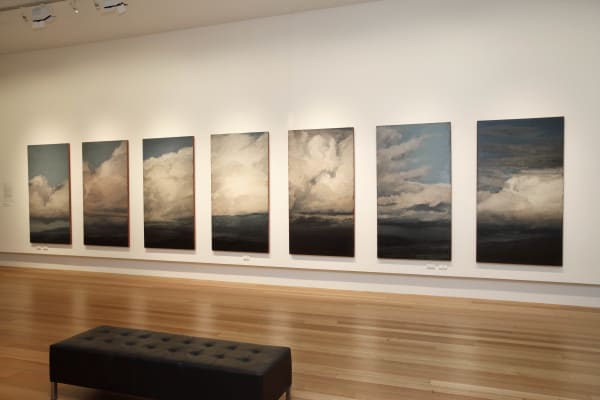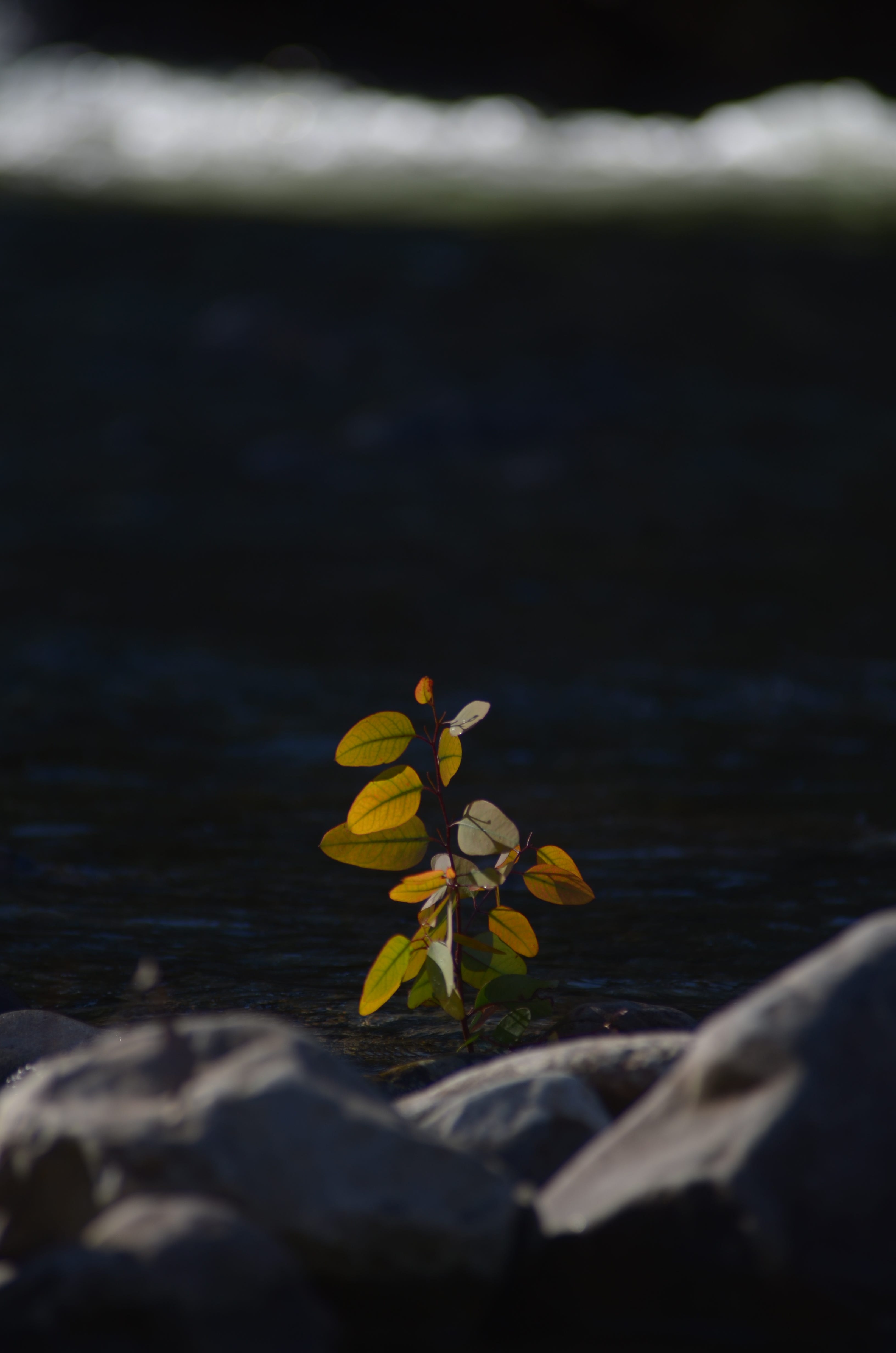Landscape painter Philip Wolfhagen has gone down a rabbit hole and hasn’t been seen for weeks. He’s following an idea, an emotion, an intuition about interpreting Tasmania that is solely his own, and he badly wants to paint and share it. He’s found his muse and is swiftly painting interpretations of clouds and trees and landscapes that he has seen in the wilds and in the warrens of his soul.
I have come out to visit Wolfhagen’s studio on his farm near Longford, to watch him paint and to talk with him about what he does. Through the windows of the chapel-shaped barn that he built himself on a quiet hillside above the South Esk River, I can see sheep grazing peacefully in the paddocks. Wide views stretch across the green and gold farmlands that lead up to the dark slab of mountains, the Great Western Tiers, which frame the distance like a frozen sea wave. This is a view that Wolfhagen has drawn inspiration from for the past 45 years, since moving to this area from nearby Isis Valley when he was 12 years old. The Tiers are deeply etched into his DNA and imbue many of his paintings.

When I walk into the studio, I walk in unobserved. There is a Bach choral passion playing full volume and a man is standing by a wall, furtively spreading thick oil paint with a palette knife across a canvas that is only half finished but already speaks of the subtle light and boldness of Tasmanian skies. I have caught him in the act, down a rabbit hole, in the early stages of creating a vision of the Tasmanian landscape that will no doubt end up in a museum, gallery or home far away from here. But for now the painting is here in this little country studio, coming to life with the music rising and creamy paint being splayed across it.
I hate interrupting him, drawing him back to the other side of the looking glass, but it is teatime and he doesn’t seem fazed by my presence. He comes out of the world he was in without much ado, turns down the music, and brings me a cup of tea. We sit midst the studio, surrounded by paintings in all sorts of stages of production, and we talk about his work, his love for Tasmania and his sense of place here on the banks above the South Esk River.
I ask him about the music.
“I almost always paint with music playing – chamber music, passions or sometimes music that is a bit edgy – like Shostakovich or Benjamin Britten. Music is a touchstone for me. It takes me back to a different time and place. It shuts down the outside world and creates a silence. I use music to heighten my state of consciousness.”

He says the music elevates his spirit and helps him fully discover what he has found in a previously seen landscape, drawing upon photographs and notes (he rarely paints in the field). “I often listen to religious music because what I am doing is of a spiritual nature – even the way the paintings are propped up on the wall in front of me, it is like an altar. Painting is a form of propitiation. “I often do my best painting when I am less conscious of what I’m doing. The music helps me become a conduit between nature and painting.”
I ask him about going down a rabbit hole, about pursuing a certain idea about a landscape that he wants to communicate. Essentially, I am asking the most basic of questions that all artists confront: Why do they create?
“I am chasing the absolute love I feel for the world we live in, for the Tasmanian environment, and I want other people to feel that too.
“Painting can’t be described scientifically … what it communicates … there are things about the human experience that can’t be explained – that’s why people make art.”
. . .

Wolfhagen may be painting the unpaintable, however, he is well-trained in art etiquette, eloquently able to discuss painting theory, history and techniques. He is not an artist lazily pontificating when he speaks about the process of painting and the skills one needs to communicate invisible things through the illusion of paint. He knows exactly what he is doing.
He graduated from the Tasmanian School of Art, University of Tasmania, in 1987. Then, after a further two years of exploratory painting in Hobart, he completed a Graduate Diploma of Visual Arts at the Sydney College of the Arts, University of Sydney.
“University training allows you to explain what you do, how you do things; as a professional you have a responsibility to articulate what you are doing and what it actually means.”
Wolfhagen didn’t start out as a painter, having majored in printmaking. He thought of himself initially as a draftsman, but soon discovered painting was his real calling.
“I locked myself up in a studio above Salamanca Place after graduating and started focusing on learning about painting and techniques through Ralph Mayer’s book, The Artist’s Handbook of Materials and Techniques. I experimented and made my own paints for two years.”

It was at the Salamanca studio that he started painting clouds he had seen in his walks in the wilds around Tasmania, and that passion for capturing the elusive light of clouds continues into his paintings today. This is truly a man with his head in the clouds. “I was obsessed with painting clouds. I was inspired by the light and colour in the paintings of Turner, Constable and the Tasmanian convict painter William Buelow Gould. I learned that painting clouds can become a metaphor for communicating something else.”
It was in Sydney that he started to paint landscapes seriously. There his artistic gifts flourished and he began to be professionally recognised; the National Gallery of Australia bought one of his paintings in 1990 from his first solo exhibition held in Sydney.
He worked part-time and painted in Sydney until 1995, when he was drawn back to Tasmania and its sense of place and the pull of home he felt there.
“It was at that point that I decided to take the plunge and really commit to painting in Tasmania full time.”
When he came back to Tasmania he and his art curator wife, Catherine, bought an old cottage near Longford and have been there ever since. He has raised a family there, manages a small farm around it and has established a remarkable garden of native and exotic plants. He tells me that when he puts in a plant he chooses ones where the colour of the leaves and flowers will blend in and complement each other – no colour is left to chance. NWalking into his garden is like walking into one of his paintings.
. . .
Wolfhagen, now in his mid 50s, is at the top of the game where he enjoys strong support from public and private collectors across the country. He has brought the Tasmanian landscape to life around the world. In 2007 he exhibited his paintings at the Australian Embassy in Washington DC, and in 2013 he was part of the Australia exhibition at the Royal Academy of Arts in London. His deeply local paintings convey universal meanings.

Wolfhagen is the Richard Flanagan and Peter Dombrovskis of the painting world, able to translate the Tasmanian environment to others in a measured and timeless way, like only the best painters, writers or photographers have ever been able to do.
. . .
I ask Wolfhagen, why this environment; why does he paint just Tasmania and no other environment? Why is a ”sense of place” important to him?
“Why Tasmania? It’s home, it’s my place. Through my paintings I am trying to create a deep sense of belonging to a place … that’s why I paint.”
Finding meaning in life is what we all pursue in one way or another, and Philip Wolfhagen finds it through mixing colours onto cloth.
. . .

Wolfhagen’s journey down the rabbit hole has produced a trove that Tasmanians should treasure, for his paintings do indeed move people and help change the world. He says he will never retire, that he will always paint. I look forward to seeing how his paintings evolve over the rest of his life and to learn about what new insights he shares with us all about our island home.
I drive away down his dirt driveway and through the open windows I hear echoes of Bach trilling and trailing over the countryside towards the South Esk. I scan the landscape and look for a way down to the river, to gather some of its magic water.
. . .
Philip Wolfhagen has had 45 solo exhibitions across the country (Sydney, Melbourne, Brisbane, Canberra, Perth and Hobart) and has won a long list of awards including the prestigious Wynne Prize in 2007 for “Best landscape painting for Australian scenery”, and the 2017 Lloyd Rees Art Prize that recognizes “an artist’s legacy and contribution to Australian landscape painting for the best painting to demonstrate light in the landscape”. In 2019 he was a finalist for Hadley’s Art Prize in Hobart where he was one of four artists presented with the Highly Commended Award.
His work is highly respected and is held in several public collections including the National Gallery of Australia, National Gallery of Victoria, Art Gallery of South Australia, Newcastle Art Gallery, New England Regional Art Museum, Tasmanian Museum & Art Gallery, Queen Victoria Museum & Art Gallery and the TarraWarra Museum of Art.

For further information, see philipwolfhagen.com.
Don Defenderfer is a native of San Francisco who once went on a holiday to Alaska where he met an Australian who told him to visit Tasmania. So he did, and while here he met a woman. That was 30 years ago. He was state coordinator for Landcare Tasmania for many years, a job that allowed him to be inspired by not only the beauty of the Tasmanian landscape but by the many people that are trying to repair and renew it. He has a Masters Degree in Social Ecology and a Bachelor of Environmental Studies with a minor in writing. He has published three volumes of poetry, and his work has appeared in newspapers and periodicals, including The New York Times and The Australian.








